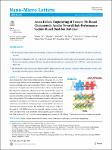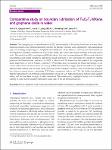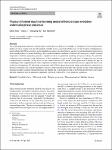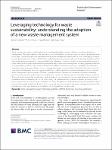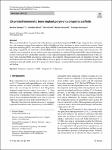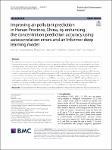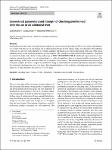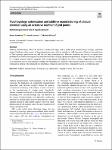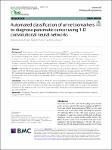Search
Author
- Amir, Ebrahimi (2)
- Aydin, Azizi (2)
- George, Haller (2)
- James, M. Fiore (2)
- next >
Subject
- robotics (9)
- Engineering (8)
- engineering (8)
- công nghệ (3)
- next >
Date issued
- 2020 - 2023 (215)
- 2010 - 2019 (28)
- 2001 - 2009 (6)
Has File(s)
- true (249)
Search Results
Sodium-based dual-ion batteries (SDIBs) have gained tremendous attention due to their virtues of high operating voltage and low cost, yet it remains a tough challenge for the development of ideal anode material of SDIBs featuring with high kinetics and long durability. Herein, we report the design and fabrication of N-doped carbon film-modified niobium sulfur–selenium (NbSSe/NC) nanosheets architecture, which holds favorable merits for Na+ storage of enlarged interlayer space, improved electrical conductivity, as well as enhanced reaction reversibility, endowing it with high capacity, high-rate capability and high cycling stability. The combined electrochemical studies with density functional theory calculation reveal that the enriched defects in such nanosheets architecture can ben... |
The emerging use of two-dimensional (2D) nanomaterials as boundary lubricants in water offers numerous benefits over oil-based lubricants; whereas the friction reduction varies significantly with nanomaterial type, size, loading, morphology, etc. Graphene oxide (GO) and Ti3C2Tx MXene, a relatively new 2D material, are investigated as boundary lubricants in water in this study. The contact pair mainly includes Si3N4 balls and Si wafer. The results found (1) monodispersed GO offers better lubricity than monodispersed MXene under identical concentration and testing conditions; and (2) the mixed dispersion of GO and MXene (0.1 mg/ml: 0.1 mg/ml) produced the lowest friction coefficient of ∼ 0.021, a value 4× and 10× lower than that produced by comparable mono-dispersions of GO or MXene, ... |
We model temperature dynamics during Shear Assisted Proccess Extrusion (ShAPE), a solid phase process that plasticizes feedstock with a rotating tool and subsequently extrudes it into a consolidated tube, rod, or wire. Control of temperature is critical during ShAPE processing to avoid liquefaction, ensure smooth extrusion, and develop desired material properties in the extruded products. Accurate modeling of the complicated thermo-mechanical feedbacks between process inputs, material temperature, and heat generation presents a significant barrier to predictive modeling and process design. In particular, connecting micro-structural scale mechanisms of heat generation to macro-scale predictions of temperature can become computationally intractable. |
Many countries are under escalating pressure to meet legally binding targets in relation to recycling and waste management. This paper explores how innovative tools, including blockchain, economic incentives, and gamification, encourage consumer adoption of a novel household waste management system. We focus on developing a comprehensive framework that combines UTAUT2 (the unified theory of acceptance and use of technology 2) with novel features in the waste management context and additional behavioral construct, intention to recommend the system to others. We tested the proposed model using the partial least square structural equation modeling approach based on a survey of 400 respondents. The results indicate that in addition to effort expectancy, social influence, and hedonic mot... |
This research introduced a new poly-ether-ether-ketone calcium hydroxyapatite (PEEK-cHAp) composite for a convenient, fast, and inexpensive femur bone-implant scaffold with different lattice structures to mimic natural bone structure. Fused deposition modelling (FDM) was used to print a hybrid PEEK-based filament-bearing bioactive material suited for developing cHAp. Using FDM, the same bone scaffold PEEK will be fabricated, depending on the shape of the bone fracture. The scaffolds were examined for in vitro bioactivity by immersing them in a simulated bodily fluid (SBF) solution. Furthermore, in vitro cytotoxicity tests validated the suitability of the composite materials employed to create minimal toxicity of the scaffolds. After spreading PEEK nanoparticles in the grains, the su... |
Air pollution is an important issue affecting sustainable development in China, and accurate air quality prediction has become an important means of air pollution control. At present, traditional methods, such as deterministic and statistical approaches, have large prediction errors and cannot provide effective information to prevent the negative effects of air pollution. Therefore, few existing methods could obtain accurate air pollutant time series predictions. To this end, a deep learning-based air pollutant prediction method, namely, the autocorrelation error-Informer (AE-Informer) model, is proposed in this study. The model implements the AE based on the Informer model. The AE-Informer model is used to predict the hourly concentrations of multiple air pollutants, including PM10... |
In the publication, the results of an experimental analysis of joint formation by pressing of DX51D steel sheets with thickness of 1.5 (mm) with the use of a rigid punch and an additional deformable rivet of various shapes were presented. The influence of the use of a steel rivet with a diameter d = 5 (mm), similar to the dimensions of the forming punch in the case of the classic clinching variety on the interlock parameters was investigated. The used die was with a four movable segments—dedicated to connections made in the clinch-riveting technology by TOX® PRESSOTECHNIK. In additional, experimental tests were made for joining sheets with a rivet of various shapes, i.e. with a through hole. Joints were formed and the correctness of the upper blockage in the lower sheet was observed... |
Additive manufacturing (AM) can fabricate complicated shapes and is useful when manufacturing topology optimized shapes. Fluid parts often consists of three dimensional curves that are suitable for AM fabrication. However, the application of fluid topology optimization and AM has not been investigated yet. However, modeling and solving an optimization problem have not been investigated for a real industrial fluid topology optimization problem of AM parts with tiny channels, i.e., a liquid atomizer which is equipped with an aero-engine fuel injector. In order to reduce computation time, which is an important issue in real industrial problem, the instantaneous sensitivity approximation method is used as a topology optimization method. The optimized part exhibited a reduction in pressu... |
Early diagnosis of Pancreatic Ductal Adenocarcinoma (PDAC) is the main key to surviving cancer patients. Urine proteomic biomarkers which are creatinine, LYVE1, REG1B, and TFF1 present a promising non-invasive and inexpensive diagnostic method of the PDAC. Recent utilization of both microfluidics technology and artificial intelligence techniques enables accurate detection and analysis of these biomarkers. This paper proposes a new deep-learning model to identify urine biomarkers for the automated diagnosis of pancreatic cancers. The proposed model is composed of one-dimensional convolutional neural networks (1D-CNNs) and long short-term memory (LSTM). It can categorize patients into healthy pancreas, benign hepatobiliary disease, and PDAC cases automatically. |
Most learning-based methods previously used in image dehazing employ a supervised learning strategy, which is time-consuming and requires a large-scale dataset. However, large-scale datasets are difficult to obtain. Here, we propose a self-supervised zero-shot dehazing network (SZDNet) based on dark channel prior, which uses a hazy image generated from the output dehazed image as a pseudo-label to supervise the optimization process of the network. Additionally, we use a novel multichannel quad-tree algorithm to estimate atmospheric light values, which is more accurate than previous methods. Furthermore, the sum of the cosine distance and the mean squared error between the pseudo-label and the input image is applied as a loss function to enhance the quality of the dehazed image. |

